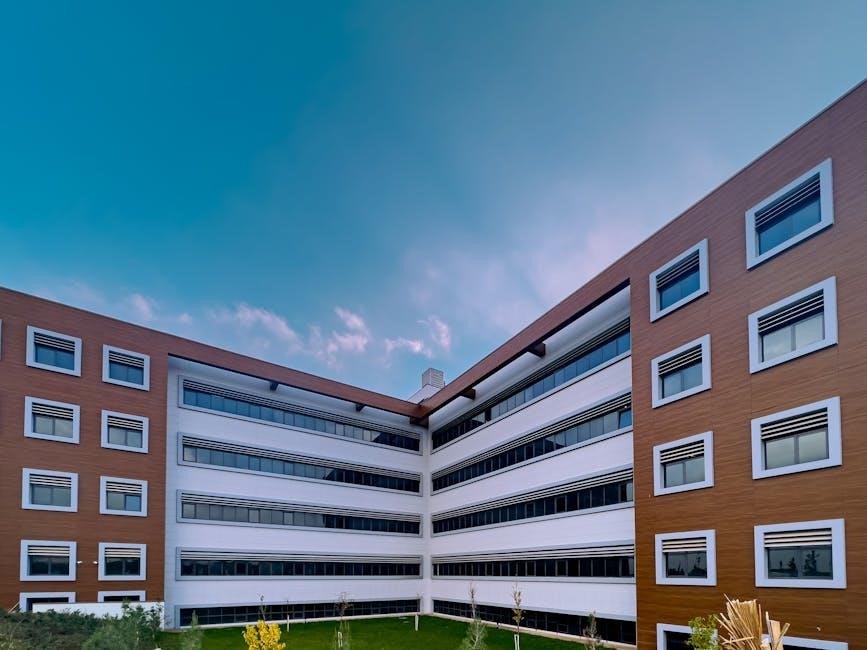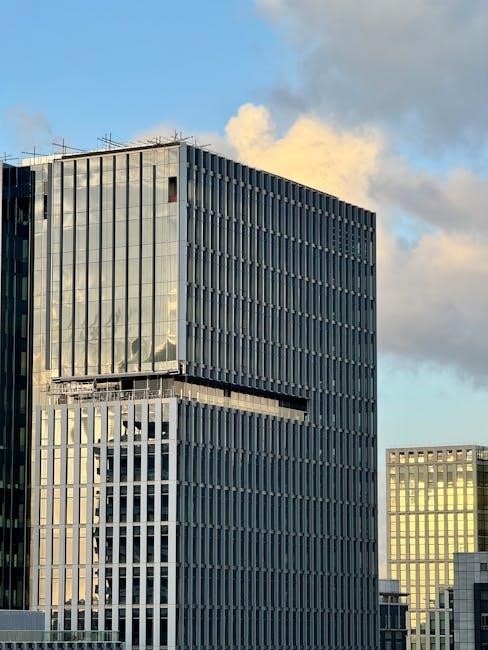Professional real estate development involves transforming land into valuable properties‚ guided by the Urban Land Institute’s principles. This guide provides a detailed roadmap from acquisition to completion‚ ensuring sustainable success.
1.1 Overview of the Real Estate Development Industry
The real estate development industry transforms land into valuable properties‚ encompassing residential‚ commercial‚ and industrial projects. It relies on financial analysis‚ market trends‚ and sustainable practices. Developers use tools like feasibility studies and ULI guidelines to navigate risks and opportunities. This sector requires collaboration across disciplines‚ adapting to economic shifts and environmental demands to create thriving communities and spaces.
1.2 Key Concepts and Terminology in Real Estate Development
Real estate development involves key concepts like site acquisition‚ due diligence‚ and project feasibility. Terminology includes NPV‚ IRR‚ and ROI‚ essential for financial analysis. Understanding land use‚ zoning laws‚ and market demand is crucial. The Urban Land Institute (ULI) provides frameworks guiding developers through the process‚ ensuring informed decision-making and successful project execution.
1.3 The Role of the Urban Land Institute (ULI) in Real Estate Development
The Urban Land Institute (ULI) is a leading authority in real estate development‚ offering comprehensive guidelines through its publications. ULI provides education‚ research‚ and networking opportunities‚ helping professionals navigate market trends‚ sustainability‚ and urban growth. Its resources‚ such as “The ULI Guide to the Business‚” are essential tools for developers‚ ensuring ethical and profitable practices.

The Real Estate Development Process
The real estate development process involves site acquisition‚ design‚ financial analysis‚ permitting‚ construction‚ and project management. It requires coordination and expertise to deliver successful projects.
2.1 Site Acquisition and Due Diligence
Site acquisition involves identifying and purchasing land suitable for development. Due diligence includes evaluating the property’s legal‚ environmental‚ and financial status. This phase ensures the site aligns with project goals and mitigates risks.
2.2 Design and Planning Phase
The design and planning phase involves creating a development concept‚ site planning‚ and architectural design. It ensures the project aligns with market demands‚ budget‚ and regulatory requirements. This phase includes zoning compliance‚ environmental impact assessments‚ and stakeholder engagement. A well-planned design lays the foundation for successful project execution and long-term viability‚ balancing aesthetics‚ functionality‚ and profitability.
2.3 Financial Analysis and Feasibility Studies
Financial analysis and feasibility studies are critical to determine project viability. They involve evaluating capital costs‚ operating expenses‚ and potential revenue streams. Key metrics include Net Present Value (NPV)‚ Internal Rate of Return (IRR)‚ and cash flow projections. These studies assess market demand‚ risks‚ and profitability‚ ensuring informed decision-making and alignment with stakeholder objectives. A robust feasibility study guides resource allocation and strategic planning.
2.4 Permitting and Regulatory Approvals
Permitting and regulatory approvals are essential for legal compliance and project timelines. Developers must navigate complex zoning laws‚ environmental regulations‚ and community reviews. Delays in approvals can escalate costs and hinder progress. Proactive engagement with authorities and thorough documentation are critical to streamline the process. Non-compliance risks legal penalties and project cancellation‚ emphasizing the need for meticulous planning and expertise in regulatory navigation.
2.5 Construction and Project Management
Construction and project management involve overseeing the building process‚ ensuring timely delivery‚ and adhering to budgets. Effective planning‚ contractor selection‚ and site supervision are critical. Tools like critical path method (CPM) and Gantt charts help manage schedules. Budget control involves cost estimation‚ tracking expenditures‚ and mitigating overruns. Safety protocols and compliance with building codes are paramount. Strong leadership ensures quality execution and alignment with project goals.
Financial Analysis in Real Estate Development
Financial analysis evaluates project viability‚ assessing revenue‚ costs‚ and profitability. It involves budgeting‚ forecasting‚ and comparing investment returns to ensure informed decision-making for stakeholders.

3.1 Understanding Net Present Value (NPV) and Internal Rate of Return (IRR)
Net Present Value (NPV) measures project profitability by discounting future cash flows to their present value‚ minus initial investment. IRR calculates the rate yielding zero NPV‚ reflecting return potential. Both metrics guide investment decisions‚ ensuring projects align with financial goals and strategic objectives. They help developers compare opportunities‚ manage risk‚ and prioritize investments effectively. Understanding NPV and IRR is critical for assessing project viability and maximizing returns.
3.2 Cash Flow Analysis and Proforma Development
Cash flow analysis evaluates the timing and magnitude of a project’s inflows and outflows‚ crucial for assessing financial viability. Proforma development involves creating detailed financial projections‚ including income statements‚ balance sheets‚ and cash flow statements. These tools help developers anticipate future performance‚ identify potential funding gaps‚ and make informed decisions. Accurate proformas are essential for securing financing and ensuring project profitability over its lifecycle.
3.3 Risk Assessment and Sensitivity Analysis
Risk assessment identifies potential threats to a project‚ such as market downturns or regulatory hurdles. Sensitivity analysis evaluates how changes in key variables‚ like interest rates or occupancy rates‚ impact financial performance. These tools help developers understand project vulnerabilities‚ prioritize risks‚ and develop mitigation strategies to enhance resilience and ensure long-term viability.

Market Analysis for Real Estate Development
Market analysis is crucial for identifying demand‚ understanding competition‚ and aligning projects with economic trends‚ ensuring informed decision-making and successful real estate development strategies.
4.1 Understanding Market Trends and Demand
Analyzing market trends and demand is essential for real estate development‚ involving economic indicators‚ demographic shifts‚ and consumer preferences. Developers must assess supply and demand dynamics‚ absorption rates‚ and future projections to align projects with market needs. This analysis helps identify opportunities‚ mitigate risks‚ and ensure projects meet target audience requirements‚ ultimately guiding informed investment and development decisions.

4.2 Analyzing Competition and Market Positioning
Analyzing competition involves evaluating existing market offerings‚ pricing strategies‚ and brand reputation to identify gaps and opportunities. Understanding competitive positioning helps developers differentiate their projects‚ ensuring a unique value proposition. This analysis enables strategic decisions on product design‚ pricing‚ and marketing‚ ultimately enhancing market share and profitability in a competitive real estate landscape.
4.3 Demographic and Economic Analysis
Demographic and economic analysis examines population trends‚ income levels‚ employment rates‚ and consumer behavior to assess market viability. Understanding demographic shifts helps tailor developments to target audiences‚ while economic data informs investment potential. This dual analysis ensures projects align with local needs and economic conditions‚ driving informed decision-making and maximizing returns in professional real estate development.

Risk Management in Real Estate Development
Risk management in real estate development involves identifying‚ assessing‚ and mitigating potential threats to ensure project success and profitability‚ addressing financial‚ regulatory‚ and operational risks effectively.
5.1 Identifying Potential Risks in Development Projects
Identifying potential risks in development projects involves assessing market‚ financial‚ regulatory‚ and operational threats. Market risks include demand fluctuations and competition‚ while financial risks involve funding shortfalls or cost overruns. Regulatory risks stem from zoning changes or permit delays‚ and operational risks include construction delays or environmental hazards. Understanding these risks early enables developers to implement mitigation strategies and ensure project viability.
5.2 Strategies for Mitigating Risks
Strategies for mitigating risks in real estate development include diversifying portfolios‚ securing reliable financing‚ and conducting thorough due diligence. Adaptive planning allows for flexibility‚ while strong stakeholder relationships help manage uncertainties. Proactive approaches ensure developers can address challenges effectively‚ minimizing potential impacts on project success.
5.3 Insurance and Legal Considerations
Insurance and legal considerations are critical in real estate development to protect against liabilities and ensure compliance. Developers should secure comprehensive insurance coverage‚ including general liability‚ property‚ and construction risk policies. Legal due diligence‚ such as title searches and contract reviews‚ is essential to avoid disputes. Compliance with zoning laws‚ environmental regulations‚ and labor standards further mitigates legal risks and ensures project viability.

Sustainable and Responsible Real Estate Development
Sustainable development balances environmental‚ social‚ and economic considerations‚ ensuring long-term value and community well-being through responsible practices.
6.1 Principles of Sustainable Development
Sustainable development emphasizes environmental stewardship‚ social equity‚ and economic viability. It prioritizes resource efficiency‚ minimizes ecological impact‚ and promotes long-term community benefits. Key principles include designing for resilience‚ reducing carbon footprints‚ and integrating green technologies. Developers should focus on creating livable spaces that support biodiversity and adapt to climate change while fostering inclusive growth and stakeholder engagement.
6.2 Energy Efficiency and Green Building Certifications
Energy efficiency and green certifications‚ such as LEED and Energy Star‚ play a crucial role in sustainable development. These programs set standards for reducing energy consumption‚ water usage‚ and environmental impact. Developers can achieve certifications by incorporating energy-efficient systems‚ renewable energy sources‚ and sustainable materials. These credentials not only enhance a property’s market value but also contribute to lower operating costs and a reduced carbon footprint‚ benefiting both occupants and the environment.
6.3 Social and Environmental Impact Assessment
Social and environmental impact assessments evaluate how development projects affect communities and ecosystems. These assessments identify potential social impacts‚ such as displacement or cultural effects‚ and environmental concerns like habitat disruption or pollution. By engaging stakeholders and analyzing data‚ developers can mitigate negative outcomes and ensure projects align with community needs and sustainability goals‚ fostering responsible and inclusive growth while minimizing ecological harm.

Mixed-Use and Urban Development
Mixed-use development combines residential‚ commercial‚ and recreational spaces‚ fostering vibrant urban environments. It promotes walkability‚ reduces car dependency‚ and strengthens community ties‚ enhancing urban vitality.
7.1 Benefits of Mixed-Use Development
Mixed-use development offers numerous benefits‚ including urban revitalization‚ enhanced livability‚ and reduced traffic congestion. It promotes walkability‚ fostering stronger community ties and local economies. By integrating diverse uses‚ it optimizes land use‚ supports sustainability goals‚ and creates dynamic‚ vibrant neighborhoods; This approach also increases property values and attracts a diverse demographic‚ making it a cornerstone of modern urban planning and development strategies.
7.2 Challenges in Mixed-Use Projects
Mixed-use projects face challenges like coordination among multiple stakeholders‚ higher upfront costs‚ and complex zoning regulations. Balancing diverse uses requires meticulous planning to avoid conflicts. Financial risks increase due to longer development timelines and mixed revenue streams. Regulatory hurdles and community opposition can further complicate projects‚ making them more resource-intensive and politically sensitive compared to single-use developments.
7.3 Urban Renewal and Revitalization Strategies
Urban renewal involves revitalizing underutilized or degraded areas to enhance livability and economic vitality. Strategies include community engagement‚ public-private partnerships‚ and leveraging incentives like tax breaks. Mixed-use developments and transit-oriented projects are key‚ as they promote density and walkability; Incorporating green spaces and adaptive reuse of historic buildings also fosters sustainability and cultural preservation‚ creating vibrant‚ inclusive urban environments that support long-term economic growth and social equity.

Case Studies in Successful Real Estate Development
Case studies provide insights into successful projects‚ highlighting strategies‚ challenges‚ and outcomes. They offer practical lessons for developers‚ ensuring informed decision-making and replication of best practices.
8.1 Lessons Learned from Iconic Development Projects
Iconic projects reveal critical lessons in real estate development‚ emphasizing vision‚ collaboration‚ and adaptability. Successful developments often combine innovative design‚ thorough market analysis‚ and robust risk management. These case studies highlight the importance of aligning projects with community needs and leveraging partnerships to overcome challenges. They also underscore the value of resilience and long-term thinking in achieving lasting impact and financial success.
8.2 Analyzing Success Factors in Real Estate Development
Success in real estate development hinges on a strong vision‚ meticulous financial planning‚ and a skilled team. Collaboration with stakeholders‚ deep market insights‚ and adaptability are crucial. Effective risk management and timely execution ensure profitability. Quality design‚ alignment with community needs‚ and long-term value creation further distinguish successful projects. These factors collectively drive sustainable growth and reputation in the competitive real estate industry.
8.3 Avoiding Common Pitfalls in Development Projects
Common pitfalls in real estate development include inadequate market analysis‚ regulatory delays‚ and budget overruns. Poor site selection and unrealistic timelines can also derail projects. Effective risk management and contingency planning are essential. Transparent communication with stakeholders and adherence to legal requirements further mitigate potential issues. Proactive problem-solving and flexibility ensure projects remain on track and achieve their intended goals without unnecessary complications or financial losses.

Best Practices in Real Estate Development
- Conduct thorough market and site analysis to ensure project viability.
- Engage stakeholders early to align expectations and goals.
- Adopt sustainable practices to enhance long-term value.
- Maintain transparency and ethical standards in all dealings.
9.1 Effective Project Management Techniques
Effective project management in real estate development involves clear planning‚ timely execution‚ and rigorous oversight. Define project goals‚ timelines‚ and budgets upfront. Use tools like Gantt charts and project management software to track progress. Foster strong communication among stakeholders‚ including architects‚ contractors‚ and investors. Regularly monitor risks and adapt strategies to maintain project alignment with objectives. Continuous collaboration ensures successful delivery and long-term value creation.
9.2 Building Strong Stakeholder Relationships
Building strong stakeholder relationships is critical for successful real estate development. Foster trust through transparent communication and regular updates. Understand the interests and priorities of all parties‚ including investors‚ community groups‚ and local authorities. Align goals and expectations to ensure collaboration. Address concerns promptly and maintain open dialogue to strengthen partnerships. Recognizing and valuing stakeholder contributions cultivates loyalty and long-term success in development projects.
9.3 Adapting to Changing Market Conditions
Adapting to changing market conditions is essential for long-term success in real estate development. Stay proactive by monitoring economic trends‚ consumer preferences‚ and regulatory changes. Flexibility in project planning allows for timely adjustments to shifting demands. Diversify asset classes or repurpose developments to align with emerging opportunities. Regular market analysis and agile decision-making ensure resilience and profitability. Embrace innovation and technology to stay competitive in a dynamic environment.
The Future of Real Estate Development
The future of real estate development lies in sustainable practices‚ technological advancements‚ and globalization. Innovations in construction and smart city integration will shape tomorrow’s built environment;
10.1 Emerging Trends in Real Estate Development
Emerging trends in real estate development include a strong focus on sustainability‚ smart technologies‚ and adaptive reuse of spaces. Green building certifications and net-zero energy projects are gaining traction. The integration of technology‚ such as AI and big data‚ is enhancing decision-making and operational efficiency. Additionally‚ shifting demographics and urbanization are driving demand for mixed-use developments and affordable housing solutions. Global investment trends and resilience to climate change are also reshaping the industry.
10.2 Technological Innovations in the Industry
Technological innovations are transforming real estate development through PropTech solutions‚ AI‚ and big data analytics. Virtual and augmented reality enhance project visualization‚ while Building Information Modelling (BIM) improves design accuracy. Smart building technologies optimize energy use and operational efficiency. Blockchain technology is also emerging for secure‚ transparent transactions. These advancements are driving innovation‚ streamlining processes‚ and creating smarter‚ more sustainable developments. They are reshaping how projects are conceived‚ managed‚ and delivered.
10.3 The Impact of Globalization on Real Estate Development
Globalization has significantly influenced real estate development by facilitating cross-border investments and market integration. International capital flows have expanded opportunities for developers‚ enabling projects in emerging markets. However‚ globalization also introduces challenges‚ such as cultural and regulatory differences. The increasing interconnectedness of global markets requires developers to adapt to diverse economic conditions‚ ensuring projects align with local needs while leveraging global trends and resources.


